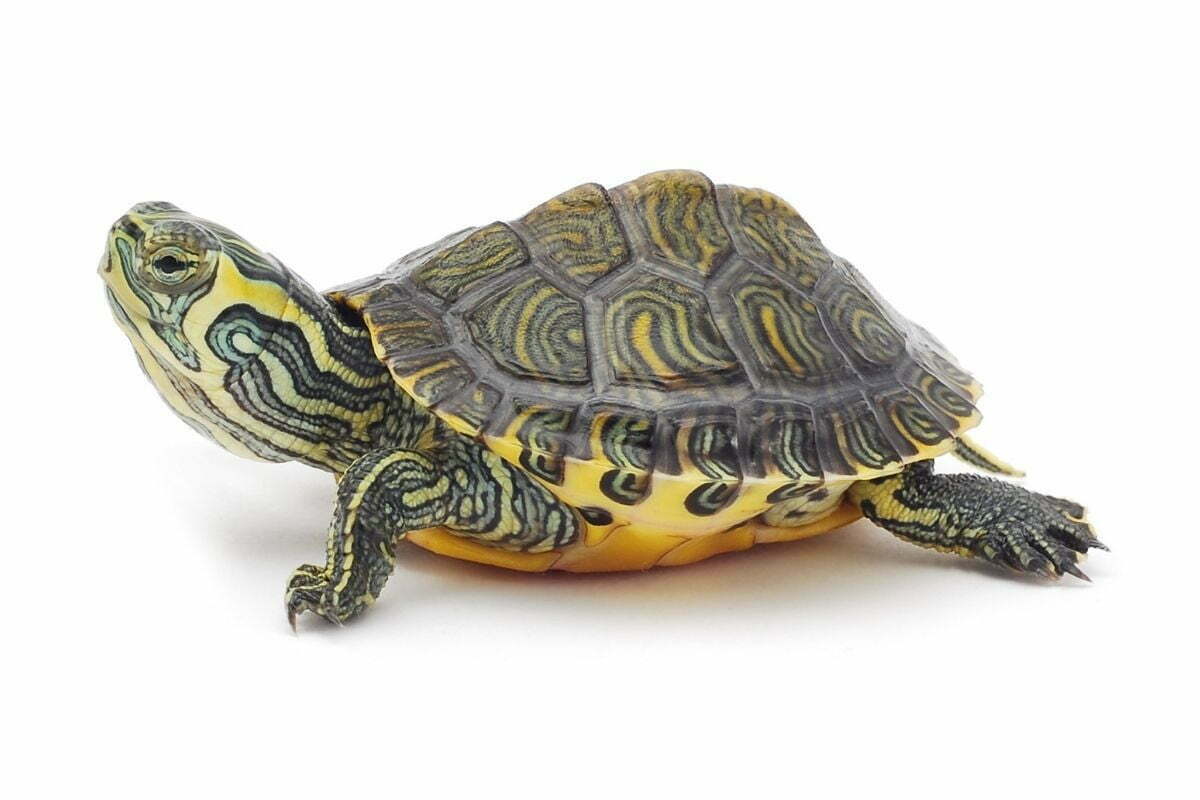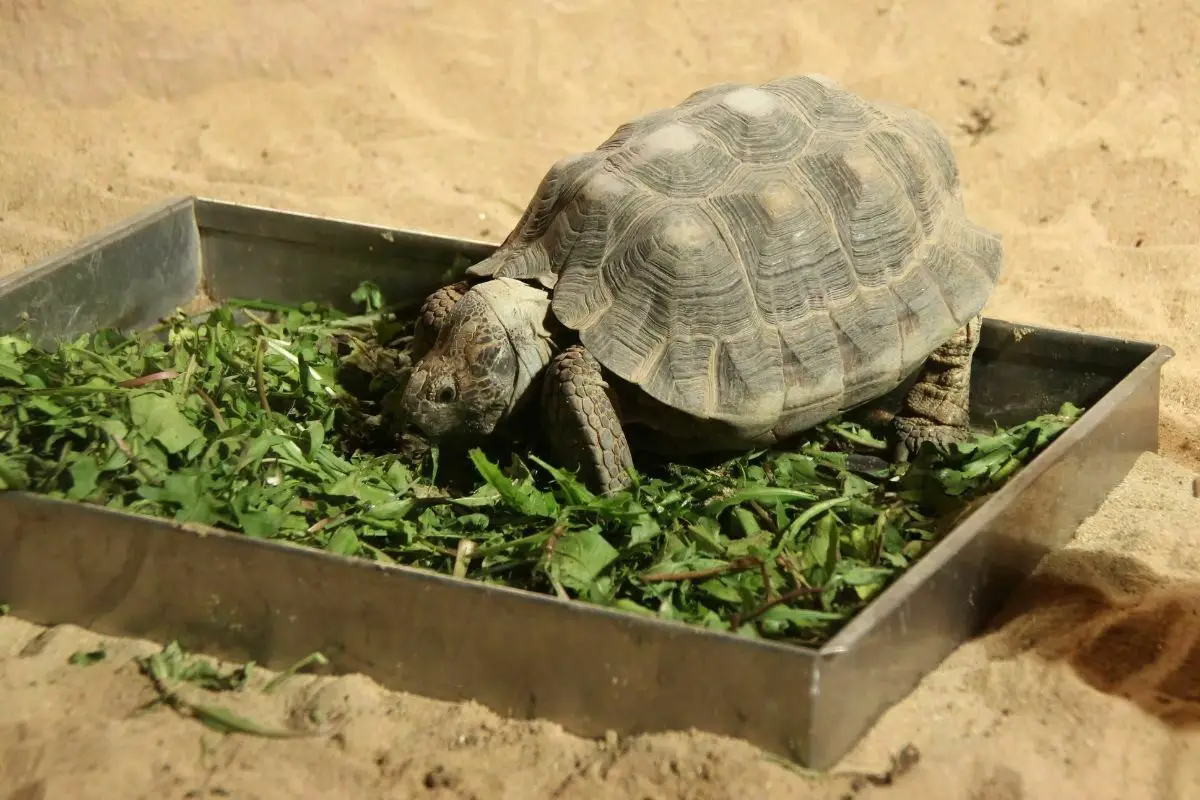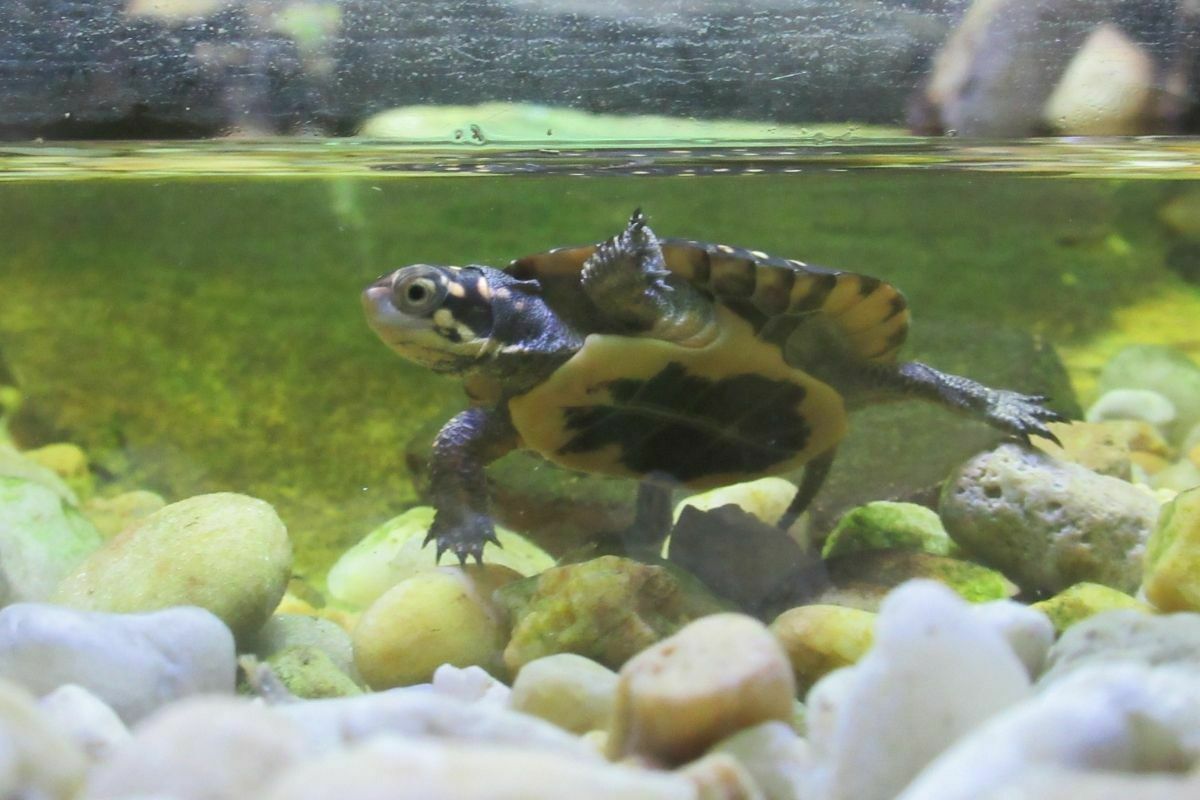Turtles are known for their longevity, and some of the larger turtles can live up to 100 years.
However, most turtles in captivity depend on their owner’s care and attention to ensure they don’t go without food and fresh water for too long.

We take a look at how long your pet turtle can live without eating. We also put together a guide on what you should do when you are leaving your turtle for longer.
How Long Can Your Pet Turtle Live Without Food?
Turtles can be very long-lived when they have a good diet. They can eat almost anything that is not poisonous to them.
How long your turtle can live without eating depends on its age.
Young Turtles (0-6 months)
Young turtles, from baby turtles to 6 months old, should not go even a day without eating. These little pet turtles are still growing.
They need specific nutrients to grow their shell and bones. If you do not provide these nutrients, they will develop problems in their growth.
So, when you get your new turtle, you need to make sure it receives plenty of attention and the right diet.
However, it’s good to be aware that if you feed your pet turtle too much food or give it too many treats, it may become overweight.
This could lead to health issues such as obesity, diabetes, heart disease, arthritis, kidney failure, and other conditions.
With small turtles, it is also important to keep an eye out for parasites, which can cause serious illness if left untreated.
Adolescent/Juvenile Turtles (6-12 months)
These young turtles are getting bigger but still need regular feeding. You can start giving them a bit more food than babies.
Adolescent turtles can’t go without food for more than one day.
If you want to increase the amount of food they receive, gradually increase the size of their meal over time.
If you notice any signs of malnutrition, such as loss of appetite, lethargy, or lack of energy, then it’s best to check with your vet.
Adult Turtles (Older Than 1 Year)
As your pet gets older, it becomes somewhat less dependent on food. You don’t need to feed your adult turtle every day.
Instead, an adult turtle only needs food every 2 to 3 days. It’s normal for older turtles to stop eating completely for a few days.
During this time, they digest what they’ve eaten and absorb the nutrients into their body.
It’s important to know that if you leave your pet alone for more than 3 days, it will need a sufficient diet to eat during your absence.
So your turtle will need someone to care for them while you are away. It’s also worth someone checking on your turtle to ensure that it has the right heating and water filtration.
Automatic filters and equipment so easily break down.
What You Should Do When Leaving Your Turtle For Longer

Some turtle species, such as turtles that live in garden ponds, don’t need regular feeding and they can often fend for themselves for a longer period of time.
However, you will still need to provide adequate food, so they can eat whenever they are hungry.
Your average pet turtle in an aquarium or terrarium needs a little more care.
Although these turtles can survive without food for long times, such as during hibernation, you shouldn’t leave your pet alone for too long.
Pet turtles are, after all, still your pet, and they do need a responsible pet owner to look after them.
Put Out Plenty Of Food
Turtles aren’t quite like cats and dogs; they do not always eat the same amount of food. Sometimes turtles eat much more than you might expect.
However, when a turtle stops eating, there may be something wrong.
You should take your turtle to the vet immediately if it doesn’t eat for longer than 5 days.
The vet will examine your turtle and determine whether it is suffering from any underlying health problems.
If your turtle isn’t eating, it may be due to a dirty aquarium or inadequate temperature.
Provide A Clean Aquarium
A clean tank is essential for your pet’s health. Before you leave, make sure your tank is clean by removing any algae or dirt buildup.
Check the filter regularly to see how well it works. If you find that the filter is clogged, then replace it.
Depending on how long you will be away, it’s a good idea to instruct someone to clean the tank during your absence.
Make sure to advise them carefully so that they don’t accidentally harm your turtle.
Make Sure The Temperature Is Right
Your turtle tank should have a heating lamp to ensure the temperature for your turtle is always steady.
This helps prevent the turtle from hibernating due to low temperatures.
As the turtle is a cold-blooded animal, it does need plenty of water for drinking and a heating lamp to keep its internal body temperature up.
Leave Enough Water
Turtles require plenty of fresh drinking water. They may drink less than other pets, but they still need to consume enough liquid to stay hydrated.
If you are planning to leave your pet for a week or two, it’s best to add extra water.
Ideally, someone should change the turtle’s drinking water regularly so it doesn’t become a breeding ground for bacteria.
Remove Any Large Objects
Turtles tend to occasionally turn on themselves, and when they turn upside down, then they cannot get up anymore.
Removing any large objects that they could fall from will reduce the risk of them turning over.
Provide Hiding Spaces
Even while you are away, your pet tortoise needs a space to hide, so you should also provide your pet tortoise with a safe place where it can hide in case of emergency.
This hiding spot must be secure because your pet turtle needs a calm space to feel safe.
Do Not Hibernate Your Turtle
Hibernation is a natural part of the life cycle of many reptiles, and it is also a common behavior among pet turtles.
They use this state of rest to conserve energy while waiting for warmer weather.
However, even during hibernation, you need to watch your pet and ensure that it’s safe.
You should never induce hibernation in your turtle while you are going away. Hibernation is a natural cycle that occurs between November and March.
Inducing hibernation could mean your turtle’s internal clock gets out of sync, which could cause any number of health issues.
Book A Pet Sitter
It is very easy for some people to forget their pets, so it’s important to have someone who can look after your turtle while you are away.
If you have a family member or friend who would be willing to help with this, then check with them in advance.
Otherwise, you could ask a neighbor or relative to keep an eye on your pet while you are gone.
Make sure that you leave instructions with whoever is caring for your pet. You should also ensure that they know what to do if something goes wrong.
It’s also a good idea to have regular calls with your pet sitter, especially when you are away for longer. You can then check with the pet sitter if your turtle is eating enough and if anything unusual has happened.
Ideally, you should look for a pet sitter who has experience handling turtles or reptiles.
Risks Of Leaving A Turtle Alone For Longer

As mentioned above, it is important to remember that your turtle is still your pet.
Therefore, even though a turtle can live without food for a little while, it is not recommended.
This is also because leaving your turtle in an aquarium or terrarium on its own is a big risk.
Some turtles turn on themselves, and as they cannot get up on their own, this would mean certain death for them.
In addition, there are many dangers associated with leaving your pet alone for too long.
For example, if your pet has been left alone for a few weeks, then it could start to lose weight.
This means that they might not be able to eat properly, which could lead to serious problems. And the person who is looking after your turtle may not spot the signs immediately.
Turtle Diet During Your Absence
The diet of most pet turtles depends on the species. However, all turtles require at least one protein source, such as meat, fish, or eggs.
There are also many different types of vegetables available for feeding your turtle. Some vegetables are better than others, depending on the number of nutrients they contain.
When choosing a suitable diet for your turtle, you should consider how much time you will be away from home.
If you plan to be away for more than three days, then you should make sure that your turtle has access to water, as well as someone who feeds your turtle fresh food.
Baby Turtle Diet
Just like with most baby animals, it’s best not to leave your baby turtle. If you need to travel for a few days, then make sure that someone is looking after it.
A baby turtle cannot go weeks without food. It shouldn’t go even a day without eating.
Young turtles usually eat small amounts of fish, insects, worms, and other invertebrates. They don’t normally eat plants until they reach around six months old.
However, young turtles can sometimes eat grasses and leaves. This is why providing plenty of vegetation for your baby turtle is important.
You should also give your baby turtle some calcium-rich foods. These include shellfish, milk, cheese, yogurt, and egg yolks.
You should avoid giving your baby turtle any type of fruit in moderation, as they contain a lot of sugar.
Adult Turtle Diet
Once your turtle reaches adulthood, it will still eat meat, insects, and worms.
It’s also important to feed your adult turtle a variety of fruits and vegetables. As these are high in vitamins and minerals, they help keep your turtle healthy.
It’s also very important to ensure that your adult turtle gets enough calcium. You can do this by providing it with shellfish, milk, and cheese.
There should be a good supply of food for your turtle while you are away. It’s best to feed fresh food.
Although turtles do not drink much water, you should always ensure to provide plenty of fresh, clean water.
Frequently Asked Questions
How Often Do Turtles Need To Eat?
How often your turtle will need to eat depends on its age, species, and size. A baby red-eared slider, for example, will happily eat every day.
However, as your turtle gets older, it will likely only need a good portion of food every two or three days.
What Are The Signs Of A Dying Turtle?
One of the first things that you should look out for is if your turtle stops moving. Another sign that your turtle is dead is that it has lost a significant amount of weight.
There are many reasons why a turtle suddenly dies. Sometimes it is a lack of care; other times, an underlying health issue.
Look out for symptoms such as lost appetite, weight loss, lethargy, or bleeding.
Does A Dead Turtle Float Or Sink?
When your turtle dies, it will start to decompose immediately. Depending on your climate and your turtle’s species, dead turtles can float on the water for up to 32 hours.
After that, they begin to sink and decompose faster.
Conclusion
Turtles are amazing creatures. However, they require a great deal of attention and care, especially when you are planning to go away.
We hope our guide to how long your turtle can survive without food will help you and your pet to have a safe time.
